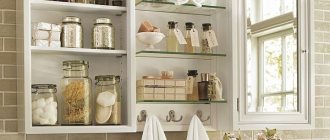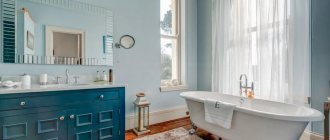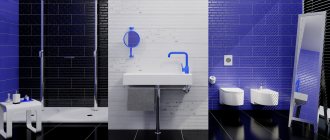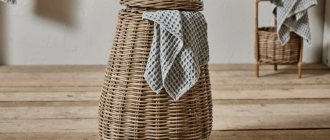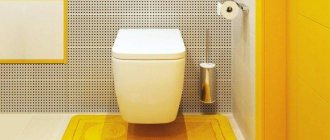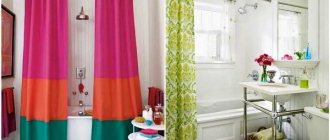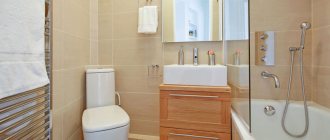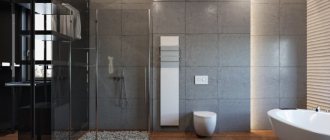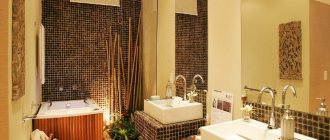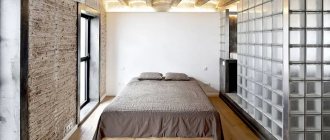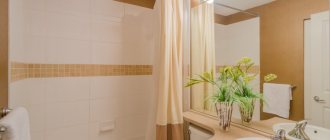The bathroom is a high-humidity area, since splashing around in the bathtub or taking a shower can’t be avoided without splashes flying everywhere. As a result, mold and mildew may appear, which means that this room will need to be treated or the finishing will have to be changed.
A bathroom partition is practical, convenient and stylish.
To ensure that there are fewer puddles after washing, install a bathroom screen, or, as it is also called, a protective screen or partition. Retail outlets offer a huge selection of this design in different shapes and from various materials, so choosing the right one for your interior will not be difficult.
The cost of the partition is much higher than that of conventional curtains. But it will serve you for many years.
Advantages of screens and recommendations for selection
The previously widely used simple curtains are no longer so popular. They were mainly taken because of the low price. This element of protection is a losing option compared to screens.
- The bathroom screen perfectly protects the floor and walls from moisture flying everywhere.
- Does not require special care or frequent cleaning.
- Prevents the appearance of fungus.
- The screens are very convenient: they do not stick to the body during washing, and a draft will not open them.
- Glass and plastic will last longer than oilcloth or rubberized fabric.
- The installation of the structure is quite simple; you can do it without the help of a specialist. This design can be mounted in bathrooms of different layouts. And in order to make the right choice, you should know the features of different screens.
When choosing a screen for your bathroom, first of all you should take the correct measurements.
Screen care
Regardless of whether we decide to buy a screen made of glass, plastic or hang a curtain, it is important to take care of maintaining cleanliness. Screens that are not cleaned on time will quickly become unusable, since such structures are an ideal place for mold to accumulate, and this is harmful to health.
The screen walls are wiped with a soft cloth soaked in water with the addition of delicate detergents. Granular cleaners and organic solvents (acetone, benzine, phenol) should not be used to clean such surfaces. It is advisable to periodically lubricate sliding doors with cosmetic or technical Vaseline - they will be easier to move. Some companies charge extra for glass with a special impregnating agent. From such a protected surface, water collects in large drops and streams - it flows faster and leaves fewer stains, and the one that remains is much easier to remove. Frameless screens are easiest to clean. They do not have profiles between the frames in which dirt accumulates.
Bath or shower? This dilemma often accompanies us when renovating a bathroom. If we already have both solutions, we can allow ourselves a little luxury and enjoy water treatments according to our mood. But it often happens that in the evenings we want to take a bath, and in the mornings we need a shower. But our resources and room sizes do not always allow us to install both types of plumbing fixtures. A modern sliding screen under the bathroom offers us an alternative solution to this problem. With it, both conveniences are possible even in the smallest room. And this will require several times less money than buying two plumbing fixtures installed side by side.
The vast majority of modern models of such devices are made of tempered glass; they look very attractive. In addition, the variety of shapes, attractive designs and elegant chrome details allow the imagination to run wild. A wide selection of bathing room products allows you to combine aesthetics with functionality. Thus, time spent in the bathroom becomes synonymous with relaxation and care for the physical and mental state of the body. The combination of functionality, high-quality technical and unique aesthetics will allow everyone to make a good choice.
What to consider when choosing a screen (corner bath or straight)
To select a screen correctly, you need to adhere to some rules. First of all, you need to take measurements, and when choosing, take into account that there is a gap for ventilation between the ceiling and the top of the screen. If the wall partitions are uneven or there are distortions, you should choose screens that have adjustable hinges. The size of the room also matters.
If you are installing a bathroom screen for the first time, it is better to build a single-leaf fixed frame structure - it is absolutely functional, but does not cause much trouble with installation.
For a small bathroom, transparent designs are ideal. If the bathroom is combined, multi-colored screens or with a matte finish are most suitable. But in this case additional lighting will be required.
In spacious rooms it is better to install “accordions” or hinged screens.
The strength and service life of the screen depend on the quality of the fittings (fasteners, rollers, hinges) and proper installation. Here you must follow the instructions, be precise and careful.
Design features of sliding screens
Any sliding screen is made of glass or plastic and can have a solid or composite structure and a frame or frameless type. The frame is understood as a supporting structure made of aluminum or plastic, designed to organize the operation of the screen. Frameless systems are more attractive and are made of thick-walled glass 8 mm thick. In turn, thanks to the frame, the thickness of the panels can be reduced by 2 times. Solid frameless screens are installed to enclose a specific area in the room, but their cost is much higher than that of other similar products.
Related article: Wallpaper for the kitchen in different styles: Provence, modern, country
Composite structures in most cases have a sliding principle for opening the doors. The number of panels in such a screen may vary depending on the characteristics of the bathroom. The most popular models are those that have two screens that are fixedly fixed, and the other two move in special grooves or using a roller mechanism. Such designs are perfect for bathrooms, in which every meter of usable space should be used to its maximum benefit. However, not every homeowner will like to find themselves in a closed box, especially if it is opaque. Therefore, it is advisable to use transparent sliding barriers in combination with high-quality lighting.
Also popular are accordion screens that operate on a sliding principle. When folded, this design takes up virtually no space. With a slight movement they can be folded near the wall or bathroom and also quickly brought into working condition. The disadvantage of such a protective system is its fragility and vulnerability in the places of fastening mechanisms, of which there are not so few in such a design.
Choosing a screen design
The designs are very different, there are tinted, transparent, with a pattern, matte, they partially cover the bathtub or completely, while it looks like a shower stall.
Due to the fact that such a product can be made with your own hands, it is very popular among homeowners.
Today it is impossible to imagine a bathroom without this item. A screen can significantly change the look of a room for the better and create a harmonious design. When choosing the color of the screen, the degree of transparency, rely on your taste, and also take into account the color scheme of the bathroom and plumbing fixtures.
You need to work with glass without a frame carefully, because it is heavy and quite fragile, but the result of the work is worth all the effort.
Not everyone prefers dark colors, which also visually make the room smaller. A matte partition will look bulky. The fashion for bright, large patterns is quickly passing, and besides, such a screen design will soon become boring.
Polycarbonate
Polycarbonate is a universal material that can be used both in country house construction and to create internal partitions for residential premises.
Polycarbonate has many useful properties:
- It is highly heat resistant and can withstand severe temperature changes.
- This material is distinguished by excellent mechanical strength. This allows you not to worry that the bathroom screen will split from an accidental blow.
- Polycarbonate is highly resistant to various cleaning agents. For this reason, it is quite easy to clean.
- The small weight of polycarbonate products allows you to construct large structures from it - they still remain practically weightless.
- It is quite difficult to damage this material during installation. The same cannot be said about glass screens.
All these useful properties indicate that polycarbonate is ideal for installation in the bathroom. Plastic screens are much cheaper than others.
What screen material to choose
Bathroom screen - this system is very durable and at the same time simple. Their design changes regularly, but the mechanism of action is the same. Now everything is being done to make using them comfortable. Previously, they were installed not to avoid splashing water when washing, but to decorate the room. They were mostly wooden. Now these structures are made of glass and plastic.
Transparent panels that imitate real glass are often used.
Sliding glass screen for a bathtub - advantages and disadvantages
The glass used for screens is quite durable and can last for many years. Such screens look great and are also environmentally friendly. You don't have to worry about your health due to harmful emissions and fumes. It is easy to care for.
Glass is an aesthetic material that, even after many years of use, does not lose its attractiveness.
On a note. Glass is widely used by designers when decorating bathroom interiors. Shelves and sinks made from it are increasingly in demand, despite the high cost.
If you decide to make a screen out of glass, choose the triplex option - it is much stronger than its analogues and, if deformed, does not crumble into fragments.
Different colors and textures allow you to choose a screen for any bathroom. Previously, glasses had a matte finish, “bumpy” or colorless. Now they produce patterned, colored, and tinted ones.
The material does not contribute to the formation of fungus in the bathroom and is very easy to clean.
A transparent glass bathroom screen will suit any interior, maintaining the integrity of the space. Matte divides the room into zones and protects it from prying eyes. Colored or patterned - a wonderful decorative element and a bright accent in the design of the bathroom.
The number of color shades of opaque canvases is simply amazing in its diversity.
But there are also disadvantages to glass screens. If there is a large mechanical load, damage may occur. It will be difficult to mount the screen if the walls are uneven or if the bathtub has a curved profile. It is better to install plastic ones here.
Plastic screen and its features
Such a screen will cost much less. It can be installed even with uneven walls and can cope with this work without outside help. There are also transparent plastic screens that look like glass. Opaque ones are presented in a wide range of colors, so choosing the best option will not be difficult.
Plastic is a practical material, attractive with its low cost.
The disadvantage of such a screen is that it quickly becomes dirty and requires constant maintenance. It is not recommended to use abrasive products for washing, only soft ones. In addition, plastic is not an environmentally friendly material. Since there is a temperature difference in the bathroom, it releases harmful substances. This is also unfavorable for the appearance; over time it deteriorates and the screen needs to be replaced. This material is easy to bend.
Plus plastic - a huge variety of colors and decor.
High quality performance
Typically, the screen is made from sheets of opaque material, so that when the shower is used by one person, other family members can enter the bathroom without embarrassment. The tightness of the joints is achieved through precise fitting of the components and the use of suitable seals and gaskets at the joints.
To make the screen look appropriate, you should also pay attention to its dimensions. Optimal sizes are calculated based on the following parameters:
- bathroom lengths;
- ceiling height;
- the level at which the shower is attached to the wall;
- pressure in the water supply network.
There are several types of screens for bathtubs: framed and frameless, movable (folding, sliding and push-opening), fixed and combined. Sliding panels are supported on guides mounted on an aluminum frame or directly on the walls; folding panels are supported on hinges and hinges made of material resistant to high humidity. The ease of use of the design directly depends on the degree of its ergonomics.
The main materials used in the construction of such screens are impact-resistant polycarbonate and acrylic, so you should not be afraid that an accidental careless movement or fall will lead to injury. Unlike glass, polycarbonate is lightweight and characterized by increased strength, withstands significant temperature changes and exposure to aggressive synthetic detergents.
Another variety is a model of similar design, made of 6-8 mm glass, which does not fade or fade over time. They last longer, but are significantly more expensive. Glass is a rather heavy base, which is why it requires a careful and reliable method of fastening. The surface is extremely difficult to scratch, and this feature helps the partition maintain its original appearance for a long time after installation.
You may also be interested in: Glass curtains in the bathroom - types and design
A well-made bathroom screen will last for years without any complaints. It is very easy to clean: immediately after bathing, just rinse it with running water from the shower, and once every 1-2 weeks you need to spray a liquid cleaner on the surface and after 5 minutes wipe it with a lint-free cloth.
How not to buy, but to make it yourself
If you want to make a screen yourself, go for it, it’s not that difficult, it doesn’t require a lot of expense or certain skill.
So, you will need: colorless plastic panels, an aluminum profile of the required size, fasteners, a handle, and sealant. In addition, you will need a hammer drill and attachments for it, a saw or grinder, a stationery knife, a screwdriver, a building level, a pencil, a measuring strip or a tape measure.
First of all, we take measurements of the future screen, taking into account that a gap is needed between the top of the structure and the ceiling for the passage of air. Then we make marks on the material and cut out the details. The edges must be cleaned and the handle secured.
We prepare guides of the required size from the profile.
On the wall partitions we mark the fixation points for the guides; for this we use a building level. We make holes with a puncher, attach the profile to the wall partition using dowels, having previously applied sealant to it.
We fix one of the guides with sealant to the side of the bathtub and let it dry thoroughly.
After a while, we check whether all the elements are securely fixed, then we insert part of the plastic panel into the resulting frame.
We check that it does not wobble and slides freely along the guides.
Additional Information. A screen made by yourself will meet all the characteristics and create coziness in the bathroom.
Any craftsman should know the principles of installing a screen in the bathroom. Only in this case the work will be done at a high level, and the design will delight you for many years.
The screen not only protects walls, floors and furniture from water, but also effectively decorates any interior.
Manufacturing procedure
Diagram of a frame sliding device
Assembling a bathroom screen with your own hands should be done in the following sequence:
- First of all, let's estimate the dimensions of the future screen and make markings on a plastic sheet.
- After this, using a painting knife, we cut out a plastic panel blank of the required size, finish it and attach a decorative handle to it.
- Using a hacksaw, we cut the aluminum profile into pieces of the required length (in accordance with the selected screen dimensions).
Installation of sliding screen doors
- Focusing strictly on the level, we mark the places where the profile is attached along the walls of the bathroom, after which we drill holes for the dowels.
- Using a special sealant, we mount the lower frame guide directly on the side of the bathtub.
- Using self-tapping screws, we attach the side profiles of the frame to the walls and attach the upper guide to them.
- After this, you can try to insert the prepared plastic panel into the resulting frame and make sure that it is easy to move along the guides.
Roller mechanism for bathroom
You can try to make a screen from glass of any texture you like (tinted, frosted, patterned or transparent). But at the same time, you will need qualified assistance from a specialist who knows how to professionally handle glass.
Screen for the bathroom - 50 options in the interior:
Materials used
To install the screen you will need:
- guide profile (aluminum can withstand heavy loads and will last longer);
- sheets of plastic or glass cut to size;
- silicone sealant;
- accessories: hinges, screws, etc.
Transparent materials are the most popular: they are economical and do not overload the interior. The most expensive option is tempered glass with a decorative pattern.
Plastic or polycarbonate
Plastic attracts with its variety of colors, decor and low price. It is practical, easier to work with at home: it is easy to cut, does not prick, etc. The main disadvantage of this material is that it will not last as long as glass or polycarbonate, it is easily scratched and quickly loses its appearance.
When choosing this material, keep in mind that plaque and dirt appear on it quickly. With insufficient care, the appearance becomes untidy and the surface becomes cloudy. Fungus or mold may appear.
Polycarbonate is a durable, versatile polymer. It is lightweight and impact-resistant, therefore safe and easy to install.
It is more practical in operation than plastic; it can easily withstand high humidity and temperature changes, which is why it is often used for making cabinets and screens. In appearance and durability, things made of polycarbonate are no worse than glass.
Glass
This material is not as impact-resistant as polycarbonate, although high-quality tempered glass comes close in this characteristic. The safest and most durable is triplex. The risk of injury when using it is minimal: if such glass breaks, it will not crumble into small and sharp fragments.
The remaining performance characteristics of this material are higher than those of plastic. Mold does not form on it; its surface can be easily cleaned with a special product and a cloth or paper napkin.
This is interesting: How to make a curtain for the bathroom with your own hands
A transparent glass screen is a win-win option, suitable for any style of bath design.
Classification by design
For bathtubs, a sliding partition is chosen, as is a shower screen. Mobile structures do not require free space near the water treatment area. At the same time, they reliably protect the room from splashes of water. Stationary products are installed on the sides of the bathroom or fixed to the walls.
The following design features of partitions are distinguished:
- frame;
- frameless;
- combined;
- composite or whole.
A frame screen, consisting of a plastic or metal frame, allows the use of polycarbonate or glass panels. The product has a high degree of reliability.
Frameless screens are made of tempered impact-resistant glass. Often they cover only half of the bathtub, and the edges have a rounded shape. Such structures are called corner.
A frameless screen can be opened using a hinged or sliding method. Hinged models swing inward or outward. In rare cases, a fixed screen is installed.
Advantages of a sliding protective structure
A polyethylene bath curtain is one of the most popular options for protecting the main room of the bathroom from splashes while a person is taking water procedures. Such products are quite inexpensive, and their range on store shelves simply amazes the consumer. But over time, limescale, mold and mildew form .
But progress does not stand still and all the favorite curtains have been replaced by modern screens - more reliable, durable and practical designs. They can also be easily found at any plumbing store or made yourself. In addition to the fact that such a system copes 100% with protecting the bathroom from splashes, it also has a number of advantages, the main of which are the following:
- high level of reliability - the screen effectively protects objects in the bathroom from splashes, and the floor remains dry and non-slip;
- ease of care - caring for plastic or glass does not require much effort, since such material practically does not get dirty;
- attractive external component - a variety of shades and textures makes it possible to use screens in any interior design.
In addition to the generalized advantages of all sliding screens, there are also advantages inherent in individual models, which will be discussed in more detail.
